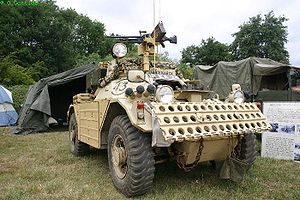Ferret (armored car)
| Ferret Scout Car | |
|---|---|

Ferret Mk.1 / 2 desert camouflage GK II |
|
| General properties | |
| crew | 2 (commander, driver) |
| length | 3.70 m |
| width | 1.91 m |
| height | 1.88 m |
| Dimensions | 3.7 tons |
| Armor and armament | |
| Main armament | 1 × 7.62mm machine gun |
| Secondary armament | no |
| agility | |
| drive | Rolls Royce B60 6-cylinder petrol engine 130 hp (97 kW) |
| Top speed | 93 km / h (road) |
| Power / weight | 35.1 hp / ton |
| Range | 306 km |
The Ferret ( Engl. : Ferrets ), also known as Ferret Scout Car , is a small wheeled tanks of the British manufacturer Daimler Motor Company , which was developed as a light armored reconnaissance and liaison vehicle. The Ferret was produced between 1951 and 1971. It was used until after the Second Gulf War in 1993.
history
The Ferret was developed from 1949 as the successor to the Daimler Dingo Scout Car used by the British Army in World War II . Since the Daimler Motor Company had designed and manufactured this successful model, it was also commissioned with the new design. The Ferret shares many similar characteristics with the Dingo, but the interior was enlarged and a machine gun turret was later installed. Production started around 1951. The first 100 Ferret still received a nameplate made of bronze, after which this was replaced by one made of brass. An aluminum shield was later used. During the Cold War , the Ferret was used by the Berlin Infantry Brigade on the Wall Patrol due to its maneuverability . The Ferret is no longer used by the British Armed Forces, but is still in use in some Commonwealth of Nations.
properties
The vehicle has a trough welded together from armored steel plates with a thickness of about ten to 18 millimeters. However, the engine cover is only about four millimeters thick. The installation of the motor, gearbox, drive and shafts inside the ferret makes the vehicle quite noisy. The Ferret has all-wheel drive and tires with emergency running properties ( "Run Flat" ). Six throwing cups (three on each side) of a smoke throwing system are attached to the front . The fuel tank holds around 100 liters of petrol and is located between the commander's seat and the engine compartment. The fuel consumption on the road is quite high at around 30 to 50 liters of petrol per 100 kilometers. The gearbox is a preselection gearbox with five gears, the clutch is a fluid clutch. The transfer case distributes the power evenly to each side. The front and rear wheels on one side are connected to one another without a differential gear. This can lead to tension in the drive train when operating on the road. The direction of travel is selected via a reversing gear so that the five gears are available in both the forward and reverse directions. The maximum speed is given as 93 km / h. However, the speedometer only has a scaling up to 50 miles / h (around 80 km / h).
Various machine guns introduced into the British armed forces were available as armament. The caliber .30 Browning MG , the Bren and later the GPMG were used. The crew had STEN and Sterling submachine guns , and later also the SA80 assault rifle. Anti-tank missiles were installed in various variants. Among other things, the Vigilant and the Swingfire were used here.
The electrical system has a voltage of 24 volts DC. The DC alternators installed at the beginning produced a maximum current of 25 amperes. In order to avoid a further decrease in the already low performance when idling, the ferrets with direct current alternator have an automatically switching gear for the alternator. Initially, the Ferrets were still equipped with VHF radios from the “Larkspur” system, but most of them were converted to the then modern “Clansman” in the 1970s. The Ferret has an on-board intercom system as standard so that the driver and the commander can communicate.
production
A total of 4409 Ferrets including 16 different versions were built between 1951 and 1971. In 2005, the Jordanian arms company King Abdullah II Design and Development Bureau developed a fundamentally modernized version called Stallion 1 , which is used in Jordan .
Versions
There are many versions (Mark) of the Ferret. They differ in their different equipment and in the use or construction of a tower and in their armament. All variants and test versions count together more than 60 different vehicle types.
Mk 1
- FV701
- Liaison vehicle
- no tower
Mk 1/1
- stronger armor than Mk 1
- sealed tub for wading ability
Mk 1/2
- rigid tower structure with a higher interior space
- two to three men crew.
- equipped with Bren - or later GPMG machine guns
Mk 2
- rotating tower from the Alvis Saracen APC
- first built
Mk 2/1 to 5
- minor improvements including stronger armor.
Mk 2/6
- FV703
- two Vigilant anti-tank missiles
- in use in the British Army and Abu Dhabi
Mk 2/7
- FV701
- Mk 2/6, after the Vigilant was decommissioned, the missiles were removed
Mk 4
- FV711
- improved Mk 2
- reinforced chassis
- Floating bellows

